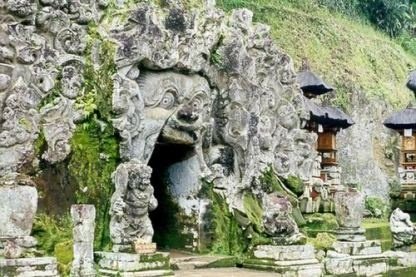
Kekunaan dimiliki objek wisata Goa Gajah
ini, bisa dilihat dari Peninggalan Purbakala. Di pelataran Pura Goa
Gajah terdapat Petirtaan Kuna 12 x 23 M2, terbagi atas tiga bilik.
Dibilik utara terdapat tiga buah Arca Pancuran dan di bilik Selatan ada
Arca Pancuran pula, sedangkan di bilik tengah hanya terdapat apik arca.
Di sekitar goa juga terdapat kolam pertitaan dengan tujuh patung
widyadara-widyadari yang sedang memegang air suci. Konon ketujuh
pancuran ini sebagai perlambang tujuh sungai penting yang sangat
dihormati di India.
Kompleks goa dan tempat
pemandian berada di sebelah barat sungai Petanu. Sedangkan pada bagian
sebelah timur dapat ditemukan goa alami dan jenis patung-patung Budha
serta pahatan-pahatan batu tebing yang sebagian besar telah jatuh di
pinggiran sungai yang juga akibat gempa bumi.
Goa Gajah, or Elephant Cave,
Located just 10 minutes outside of Ubud in Bali,
Goa Gajah is a significant Hindu archaeological site. Goa Gajah is
locally known as the Elephant Cave because of its close proximity to the
Elephant River. A mysterious cave, relics, and ancient bathing pools
set amid green rice paddies and a garden lure tourists from nearby Ubud
Despite the ancient significance of the Elephant Cave, the last excavation took place during the 1950s; many sites still remain unexplored. Literal piles of relics with unknown origins have been laid out in a surrounding garden.
The leading theory suggests that Goa Gajah was used as a hermitage or sanctuary by Hindu priests who dug the cave entirely by hand. Although accredited as a sacred Hindu site, a number of relics and the close proximity of a Buddhist temple suggest that the site held special significance to early Buddhists in Bali.
.
The menacing entrance to Goa Gajah looks like a demonic mouth, suggesting that people are entering an underworld as they venture inside through the darkness. Some claim that the entrance represents the Hindu earth god Bhoma while others say the mouth belongs to the child-eating witch Rangda from Balinese mythology.
Goa Gajah was listed as a tentative UNESCO World Heritage Site in 1995.
The History of Goa Gajah
Goa Gajah is thought to date back to the 11th century, although relics predating this time were found within proximity of the site. The first mention of Goa Gajah and the Elephant Cave was in the Javanese poem Desawarnana written in 1365.Despite the ancient significance of the Elephant Cave, the last excavation took place during the 1950s; many sites still remain unexplored. Literal piles of relics with unknown origins have been laid out in a surrounding garden.
The leading theory suggests that Goa Gajah was used as a hermitage or sanctuary by Hindu priests who dug the cave entirely by hand. Although accredited as a sacred Hindu site, a number of relics and the close proximity of a Buddhist temple suggest that the site held special significance to early Buddhists in Bali.
.
The menacing entrance to Goa Gajah looks like a demonic mouth, suggesting that people are entering an underworld as they venture inside through the darkness. Some claim that the entrance represents the Hindu earth god Bhoma while others say the mouth belongs to the child-eating witch Rangda from Balinese mythology.
Goa Gajah was listed as a tentative UNESCO World Heritage Site in 1995.
Reservation Tour contact
AGUNG : +6287862515786
email : agungputra095@gmail.com
1 day tour 800.000 ( Indonesia Rupiah)/ 1 Car
not include for enter in ticket, lunch, or other activity
Driver with English speaking



Tidak ada komentar:
Posting Komentar